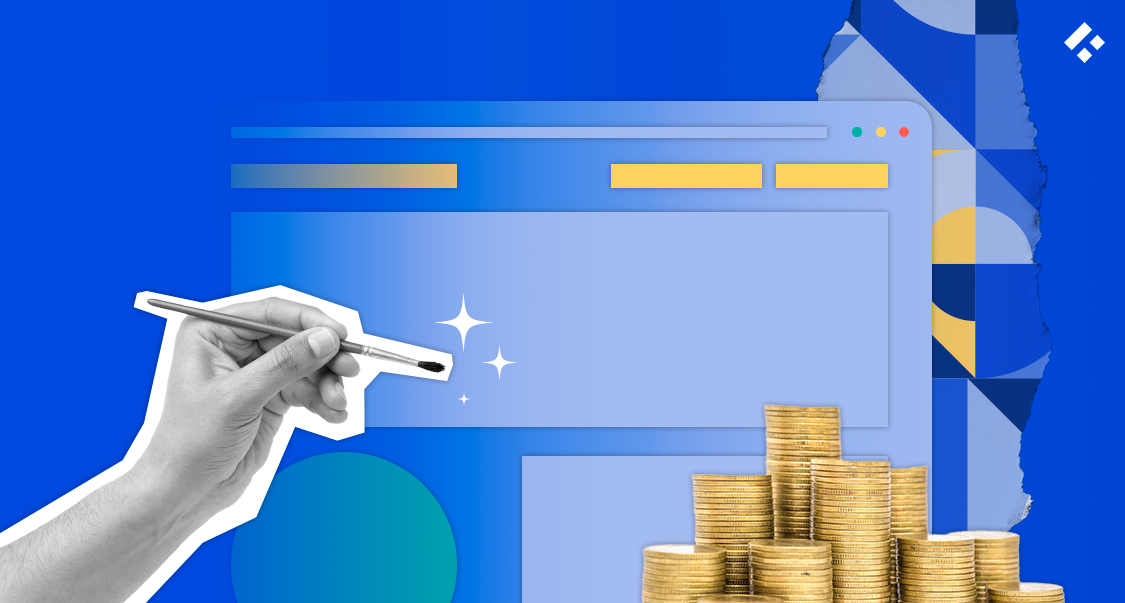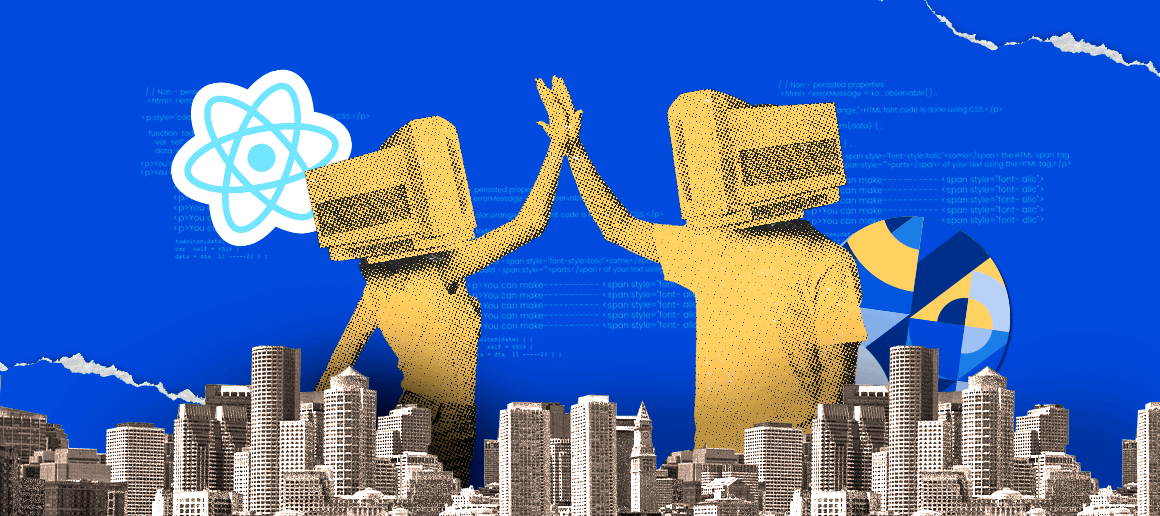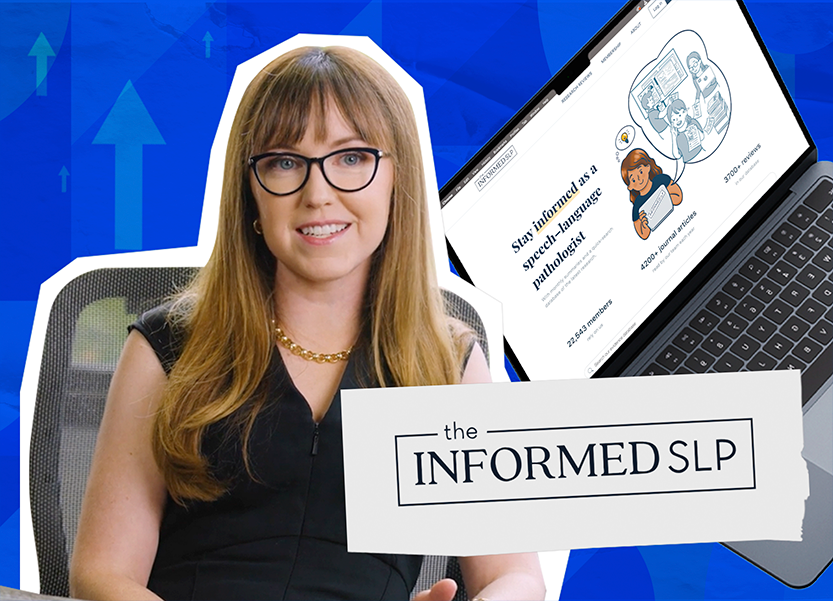When considering a website redesign, one of the most critical factors you need to consider is the price. So, what does a website redesign cost?
The truth is that redesign costs vary widely based on your specific needs. You could be looking at anything from a few hundred dollars to more than $100,000.
Let’s break down the factors that influence pricing, give you a clearer picture of what to expect, and share budgeting tips to help you maximize your investment.
If you are interested in getting your website redesigned, consider reaching out to us here at Trio. Our host of dedicated web app developers can help you redesign your website or create a new one from scratch that you can scale later.
It does not matter whether you have the technical expertise or not. Our variety of hiring options includes outsourcing and staff augmentation so that you can take on as much or as little of the technology management as you would like.
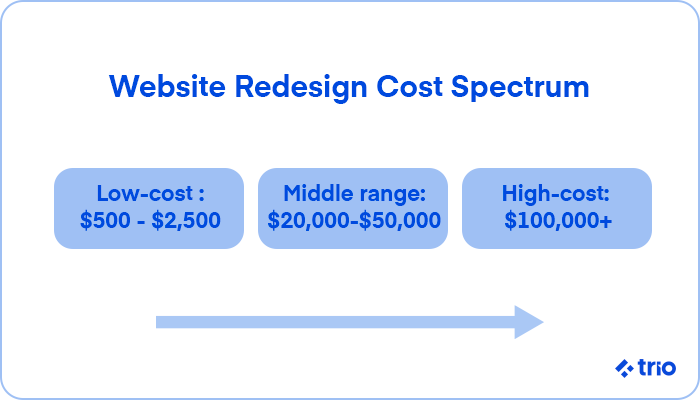
What Factors Affect the Cost of a Website Redesign?
Understanding Website Redesign Pricing Factors
So, how much does it cost to redesign your website?
Unfortunately, when it comes to redesigning your website, there’s no one-size-fits-all answer to the cost question.
There are several things to keep in mind that influence how much you’ll spend on your website redesign project.
First, the complexity of your website design will significantly affect how much your new website will cost. If your site is small and straightforward, with just a handful of pages, you can expect a lower price.
But the price can jump pretty quickly if you’re running a large site with dozens or even hundreds of pages, custom integrations, and advanced features.
Additionally, custom design is another factor. If you’re looking for something unique and tailored specifically to your brand, it’s going to cost more than using pre-designed templates.
One key element is the type of content management system (CMS) you use. If you choose a custom-built CMS, the price will likely increase due to the time and expertise required for development.
On the other hand, if you’re using a popular CMS like WordPress, costs may be lower, especially if you’re utilizing pre-built themes and plugins.
If you are unsure which of these would be the most suitable, do not worry.
Our developers will utilize effective client communication to help you take all the necessary factors into account to determine which option would be the most suitable as part of their transparent project management.
There’s also functionality to consider when you are budgeting for your website redesign. Do you need features like eCommerce, membership portals, or third-party integrations? The more advanced your site’s functionality, the higher the cost will be.
Lastly, don’t forget about SEO. If you want your new website to perform well in search engines, investing in SEO during the redesign process is crucial. While this will add to your overall cost, ensuring your site is optimized from the start is worth it.

How the Size of Your Website Contributes to the Cost
One major factor in the cost of your redesign is the size of your website, as we have mentioned above.
It is best to think of this practically – redesigning a small portfolio website with just a few pages is much simpler than overhauling a large corporate site with multiple departments, pages, and functionalities.
The more content you have, the more time it takes to migrate that content, test it, and ensure everything is functioning correctly, leading to a more costly website redesign process.
Impact of Custom Features on Website Redesign Cost
Custom features can make your website stand out and improve the user experience, but they do come at a cost.
Let’s say you want to add an interactive feature, like a client dashboard or a custom booking system. These features will need custom development, which takes time and expertise.
Since every custom element needs to be coded from scratch and tested across multiple devices and browsers, it’s easy to see why these features add to your redesign costs.
While they’re valuable, it’s important to factor them into your budget early on.
Quality developers are the way to go, even if you do not have a very big budget. With their experience and track record, these developers result in the most cost-effective development.
Trio is a great option for this, as our focus on developer well-being has allowed us to retain top developer talent in a variety of fields who can help you update your website.
How Much Does a Website Redesign Typically Cost?
Average Cost of a Website Redesign in 2024
While it’s impossible to give an exact figure without knowing your specific needs, we can look at some typical price ranges to provide you with a better idea of how much it costs to redesign a website.
For most small to mid-sized businesses, the average design cost of a website in 2024 will fall between $5,000 to $15,000.
If your site requires more custom features or it’s a more extensive website with a more significant number of pages, costs can range from $20,000 to $50,000.
For enterprise-level websites with high traffic, advanced functionality, and numerous integrations, the cost of redesigning can go upwards of $100,000.
These figures reflect the time and expertise needed to create a functional, optimized website that not only looks good but performs well across all devices.
Cost Range for Different Types of Websites
Different websites have different needs, so it’s no surprise that the costs of website redesign can vary depending on the type of site you’re working with.
For example, we have seen how a small business or simple website typically costs between $3,000 and $10,000, while a corporate site with more features and pages can range from $10,000 to $40,000.
If you run an eCommerce website, you’re likely to spend somewhere between $15,000 and $75,000 since you’ll need product pages, payment gateways, and inventory management systems.
Enterprise websites often cost more than $50,000 due to their complexity and scale.
Website Redesign Price Breakdown
Breaking down the overall price of a website redesign can help you see where your money is going.
Typically, 20% to 30% of your total cost will go toward the design and layout, including the visual aspects of your site and its structure.
Development usually takes the most significant slice, representing 30% to 50% of the total, especially if you need custom-coded features.
Content migration accounts for 10% to 15%, as moving existing pages to the new design can be time-consuming.
The most overlooked expenses are testing and launch costs, which ensure your new site works seamlessly across different devices and browsers. We have found that these can be the most important steps and are about 10% to 15%.

Discover Trio's Success Stories
See how Trio contributed to the growth of our partners and discover the potential of our team
When Should You Consider Redesigning Your Website?
Signs That It’s Time to Redesign Your Website
If you’re wondering whether it’s time to redesign your website, there are several signs to look out for.
One clear sign that your website is due for a redesign is if it looks outdated or lacks modern design trends.
Websites are the digital face of your business – often, this is the only thing people see before they make a decision on your services – and if yours looks like it hasn’t been touched in years, it might be turning away potential customers.
Slow load times, confusing navigation, or a site that doesn’t work well on mobile devices are other strong indicators that it’s time for a redesign. These can give people the impression that you are unprofessional or not trustworthy.
Additionally, if your site’s performance in search engine rankings has dropped, it could mean that your SEO needs updating, and a redesign can help address this.
How Often Should You Redesign Your Business Website?
In general, it’s a good idea to plan for a website redesign every 2 to 3 years.
This keeps your site fresh, aligned with current trends, and optimized for performance.
Technology evolves quickly, and user expectations shift just as fast, so regular updates are necessary to stay competitive. By redesigning every few years, you can keep your website looking modern and ensure that it meets your users’ needs.
Benefits of Regular Website Redesigns
Regular redesigns offer a range of benefits.
For one, we have seen how they can help you stay ahead of the competition. A modern, user-friendly website can boost customer trust, increase engagement, and ultimately drive more conversions.
Plus, regular updates ensure that your site remains optimized for search engines so you can maintain or improve your rankings. The standards for search engine rankings also shift quite quickly, so it’s important to monitor these closely.
What Are the Options for Redesigning a Website?
Comparing Professional Redesign Services vs. DIY
Whether you decide to hire professionals or go the DIY route depends mainly on your budget and the complexity of your site.
Hiring a professional web design agency is often the best choice if you want a fully customized site that’s built to scale.
Agencies – like us here at Trio – come with a team of experts who can handle everything from design to development, making sure that your website is aligned with your business goals.
However, professional services can be expensive.
On the flip side, doing it yourself (DIY) with platforms like Wix or Squarespace is much more affordable, though it’s limited in terms of customization and scalability.
DIY using website builders works well if you have a small business or a startup with a tight budget, but larger businesses with larger websites often find the benefits of hiring professionals outweigh the costs.
You also need to consider your level of technical expertise when considering which redesign option is right for you.
Choosing Between a Custom Website and a Template
Custom websites give you the freedom to design what you want, tailored to your brand and unique needs. This flexibility, however, comes at a cost, as we have mentioned already.
On the other hand, templates offer a more affordable option. While they limit your ability to fully customize your website, they’re faster to set up and much cheaper.
If you have a business that doesn’t need complex functionality or a unique design, a template-based approach could be an intelligent way to keep costs down while still achieving a professional look.
You could also start with a template when working with a development team to help reduce the overall time they need to spend coding while still reaping the benefits of their skills to a certain degree.
Cost of Building Your Own Website vs. Hiring a Web Designer
If you choose to build a website using platforms like WordPress, Wix, or Squarespace, expect to spend anywhere from $500 to $2,500, depending on the tools and features you choose.
While this is significantly cheaper than hiring a web designer, it comes with limitations.
Hiring a professional web designer or agency, though pricier at $5,000 to $50,000 or more, gives you access to their expertise and ensures your site is tailored to your specific needs.
If you are looking for a high-quality, scalable solution, this investment in an agency like Trio can be well worth the cost.
What Extra Costs Should You Expect in a Website Redesign?
A website redesign often comes with additional costs that go beyond the core design and development work.
You need to account for these when planning your budget so that you’re not caught off guard down the road.
SEO and Marketing Costs Associated with Redesign
We have briefly touched on how, during a redesign, many businesses take the opportunity to improve their website’s SEO.
If your site isn’t set up correctly for SEO, it could lose valuable search traffic after the redesign. This is why investing in SEO services during the redesign process is essential, especially if driving organic traffic is one of your business goals.
SEO services can range from $1,500 to $10,000, depending on the level of optimization required.
In addition to SEO, we recommend that you consider other marketing services, such as content creation or digital advertising, to fully capitalize on the new site launch.
Potential Ongoing Expenses After a Redesign
Once your new site is live, there are still some ongoing costs to be aware of.
For example, you’ll need to pay for website hosting. Depending on the size and traffic of your site, the monthly cost of hosting can range from a couple of dollars to $500 or more.
Another ongoing cost to consider is website maintenance. Whether it’s updating plugins, troubleshooting issues, or ensuring your site remains secure, regular maintenance is crucial to keeping your site running smoothly.
Many agencies offer maintenance plans, and you can expect to pay $100 to $300 per hour for these services.
At Trio, we can give you access to developers in nearshore and offshore countries such as those in Latin America, Africa, and Eastern Europe.
These developers are often a lot cheaper while still being extremely skilled with a track record of high-quality work, allowing you to minimize costs.
Understanding the Overall Cost of Your Website Redesign
When you’re planning your redesign budget, it’s essential to look at the big picture.
Redesigning a website isn’t just about the upfront costs of design and development; you also need to factor in ongoing expenses like hosting, maintenance, and updates.
Don’t forget about the costs of future changes or upgrades that might be needed as your business evolves. These can be new features, products, or even just higher costs associated with higher traffic.
Planning ahead for these expenses ensures you’re prepared for the long-term investment that a website redesign entails.
How Can You Budget for a Website Redesign in 2024?
Setting a Realistic Budget for Your Redesign Project
Budgeting for a website redesign can feel overwhelming, but with the right approach, you can create a plan that fits your needs and keeps you on track financially.
The first step to setting a realistic budget is knowing what you need from your new website.
Are you looking for a complete overhaul with custom designs and new features, or do you just need a refresh with an SEO update? Once you’ve nailed down your project’s scope, start reaching out to agencies or freelancers for quotes.
Be sure to get estimates from multiple sources to compare prices and services. Keep in mind that unexpected expenses may pop up during the redesign process, so it’s a good idea to leave some wiggle room in your budget to account for this.
Tips for Reducing Your Website Redesign Costs
If you’re looking to keep costs down, there are several strategies you can use. One of the best ways to save is by limiting the number of custom features you request.
While it’s tempting to go all out, sometimes simple is better – especially when you’re on a budget.
Another way to save is by focusing on improving your user experience (UX) rather than adding unnecessary bells and whistles.
Prioritizing UX can help drive more conversions, which will give you a higher return on your investment without requiring a large, complex site.
To do this effectively, we recommend that you use a front-end designer with some UX/UI experience.
How to Plan for Future Redesign Expenses
Instead of thinking of redesigning your website as a one-time expense, plan for future updates and maintenance.
Setting aside a portion of your budget for regular updates can help keep your site fresh and functional over the long term.
This could involve adding new features, optimizing your site for search engines, or updating content as your business grows.
By planning ahead for these costs, you’ll be able to spread the expense over time, making it more manageable and ensuring your site stays competitive.
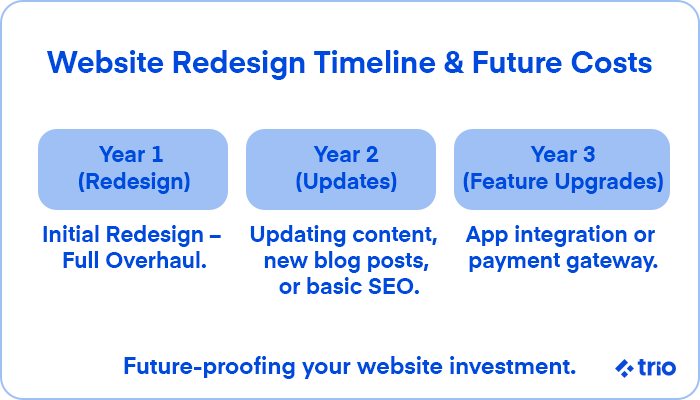
If you need help redesigning your website or creating a new website, reach out to us here at Trio. Our different models allow you to connect with highly skilled developers for long-term collaborative software development and maintenance.
